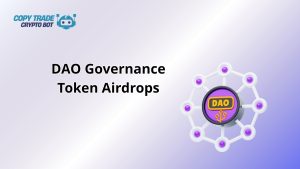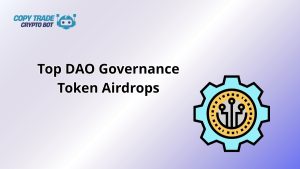Table of Contents
- 1 Introduction to DAO Governance Token Airdrops
- 2 Understanding DAO Governance and Token Airdrops
- 3 Why DAO Governance Token Airdrops Are Gaining Momentum
- 4 Types of DAO Governance Token Airdrops
- 5 Top DAO Governance Token Airdrops to Monitor in 2025
- 6 How to Qualify for DAO Governance Token Airdrops
- 7 Risks and Considerations in DAO Governance Token Airdrops
- 8 Real-World Examples of Impactful Airdrops
- 9 What’s Next for DAO Governance Token Airdrops?
- 10 Could You Be the Next DAO Leader via Airdrops?
Introduction to DAO Governance Token Airdrops
DAO governance token airdrops have emerged as a powerful incentive mechanism within decentralized ecosystems. These token distributions reward users for their participation, loyalty, and contributions to decentralized autonomous organizations (DAOs). As the DAO space evolves in 2025, these airdrops are becoming increasingly strategic, often tied to voting power, staking, or community involvement. This article explores how DAO governance token airdrops work, their growing importance, and the top opportunities in the space.
Understanding DAO Governance and Token Airdrops

What Is a DAO and Why It Matters
A DAO (Decentralized Autonomous Organization) is a blockchain-based governance structure where decisions are made collectively by token holders. Unlike traditional companies that rely on hierarchical leadership, DAOs enable members to vote on proposals, allocate resources, and shape the project’s future based on consensus.
DAO governance token airdrops distribute voting tokens to users based on predetermined criteria. These tokens empower recipients to participate in governance, propose changes, and influence the DAO’s strategic direction.
What Makes DAO Governance Token Airdrops Unique?
DAO governance token airdrops stand out from standard airdrops in several key ways:
- Purpose-driven: The tokens are not just monetary rewards—they grant users real power in shaping protocols.
- Merit-based: Most DAO governance token airdrops reward users based on their past behavior, activity level, or contribution to a project.
- Sustainable: By incentivizing governance participation, they foster long-term user engagement and loyalty.
How DAO Governance Token Airdrops Work
A DAO typically allocates a portion of its token supply for community rewards. These may be distributed via:
- Retroactive contributions: Users who have contributed in the past receive tokens.
- Staking rewards: Stakers of a project’s native asset may receive DAO tokens.
- Loyalty or participation: Users who vote, provide liquidity, or engage with the platform are rewarded.
For example, in a recent DAO governance token airdrop, users who participated in at least five governance proposals over six months received proportional airdrops based on their activity levels.
Why DAO Governance Token Airdrops Are Gaining Momentum
Strengthening Decentralization
The core goal of DAO governance token airdrops is to decentralize control. By rewarding active community members with voting power, projects reduce reliance on a few whales or developers and build resilient governance models.
Empowering Grassroots Communities
Airdrops foster a sense of ownership. Recipients of governance tokens feel like stakeholders rather than mere users, which boosts loyalty and engagement. DAO governance token airdrops are tools for community activation and democratic participation.
Driving Network Effects
By distributing tokens widely, DAOs attract more participants. Airdrops create viral loops—users talk about them, invite others, and promote the protocol. In essence, DAO governance token airdrops act as decentralized marketing campaigns.
Types of DAO Governance Token Airdrops
Retroactive Airdrops for Past Activity
Many protocols reward past contributors retroactively. For example, Optimism airdropped governance tokens to developers and early users. These campaigns are often surprise-based, boosting trust and goodwill.
Proposal Participation-Based Airdrops
Some DAOs focus on rewarding those who actively vote. Voting activity becomes the eligibility criterion for airdrops, reinforcing democratic involvement.
Staking-Based DAO Governance Token Airdrops
Stakers often receive governance tokens of new DAOs launched within an ecosystem. For instance, stakers on platforms like Cosmos or Arbitrum may get governance tokens of DAOs built on those chains.
Liquidity Provider Rewards
Liquidity providers to DEXs or DAOs’ native tokens might be eligible for governance token airdrops. These incentives drive liquidity while distributing governance power.
Top DAO Governance Token Airdrops to Monitor in 2025

Arbitrum DAO Expansion Airdrops
Arbitrum’s DAO plans to airdrop additional governance tokens to incentivize proposal creation and voting participation. Users actively contributing to the DAO’s forums, voting, or building dApps are expected to qualify for upcoming rounds.
Optimism RetroPGF and Governance Boosts
Optimism’s Retroactive Public Goods Funding (RetroPGF) rewards developers and community members. In 2025, a separate airdrop is rumored for frequent voters in the DAO and contributors who submit proposals.
Friend.tech DAO Governance Token Airdrops
Friend.tech is transitioning into DAO governance in 2025. Early beta testers, liquidity providers, and community builders are expected to receive governance token airdrops based on their cumulative engagement scores.
Starknet Community Governance Push
Starknet is distributing STRK tokens not only to developers but also to community contributors, DAO voters, and ecosystem educators. Their airdrop campaign heavily integrates DAO governance incentives.
Lens Protocol DAO Airdrop for Creators
Lens Protocol, a social graph project, has signaled a DAO token airdrop for early creators and community curators. Their model rewards contributions in decentralized social governance.
How to Qualify for DAO Governance Token Airdrops
Stay Active in DAO Governance Platforms
The most straightforward way to qualify for DAO governance token airdrops is by participating in governance: voting, submitting proposals, and engaging in discussions.
Platforms like Tally, Snapshot, and Agora are hubs for DAO proposals. Keeping an active wallet with voting history on these platforms increases your chances of eligibility.
Engage in Community Forums and Bounties
Many DAO governance token airdrops go to users who contribute to the community—whether by moderating, writing educational content, or designing UX flows. Active Discord and forum participation can be invaluable.
Stake and Hold DAO Tokens
Staking native DAO tokens demonstrates commitment. Some projects also reward long-term holders who don’t sell immediately after receiving tokens, favoring them in future airdrops.
Bridge Early to New DAO Ecosystems
Being an early user of a new L2 or DAO chain increases your chances of receiving governance tokens. Airdrops often go to users who bridge assets, vote on first proposals, or contribute feedback during test phases.
Risks and Considerations in DAO Governance Token Airdrops
Airdrop Hunters vs. Genuine Contributors
One challenge is distinguishing genuine contributors from airdrop farmers. Many DAOs now use sybil-resistance tools and proof-of-contribution models to filter out opportunists.
Token Dilution and Governance Fatigue
Excessive airdrops can dilute governance or result in voter fatigue. Projects need to balance community incentives with meaningful governance structures.
Regulatory Uncertainty
As airdrops gain popularity, they also attract regulatory scrutiny. Some jurisdictions may view governance token airdrops as taxable events or securities offerings.
Staying informed and consulting tax professionals is essential when receiving and managing DAO governance token airdrops.
Real-World Examples of Impactful Airdrops
Uniswap DAO Airdrop (UNI)
Uniswap’s 2020 airdrop was one of the first major governance token distributions, setting the standard for future DAO models. Over 250,000 users received tokens and could vote on major protocol upgrades.
dYdX DAO Token Distribution
dYdX rewarded early traders and liquidity providers with governance tokens. Their DAO oversees protocol upgrades and has substantial community involvement, thanks in part to its fair airdrop system.
ENS DAO Governance Airdrop
Ethereum Name Service (ENS) launched a governance token that was airdropped to domain holders. Voting rights now determine fund allocation, development priorities, and new feature rollouts.
What’s Next for DAO Governance Token Airdrops?
DAO governance token airdrops are evolving from marketing tools to foundational pillars of decentralized systems. In 2025 and beyond, expect more refined criteria, sybil-resistance mechanisms, and a stronger emphasis on long-term contribution over speculative farming.
DAOs may also integrate AI and on-chain analytics to score users and allocate airdrops based on holistic value rather than simple token activity. This could usher in a new era of smart airdrop campaigns that reward quality over quantity.
Could You Be the Next DAO Leader via Airdrops?
The era of DAO governance token airdrops is not just about free tokens—it’s about unlocking power, influence, and ownership in the decentralized world. Whether you’re a builder, contributor, voter, or active community member, 2025 offers unprecedented opportunities to participate and lead.
Are you ready to take your place in the DAO revolution?
